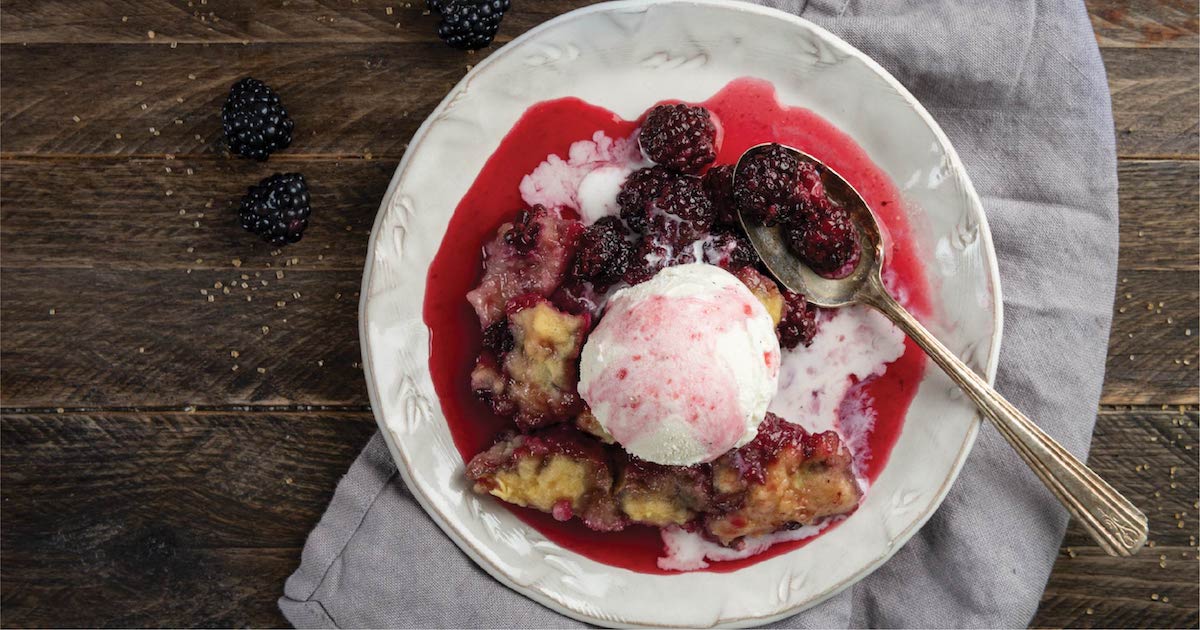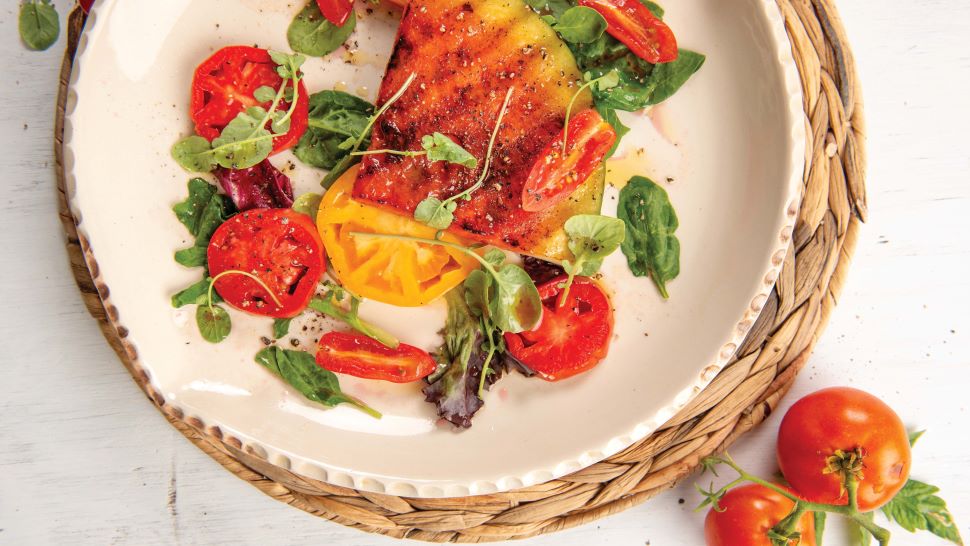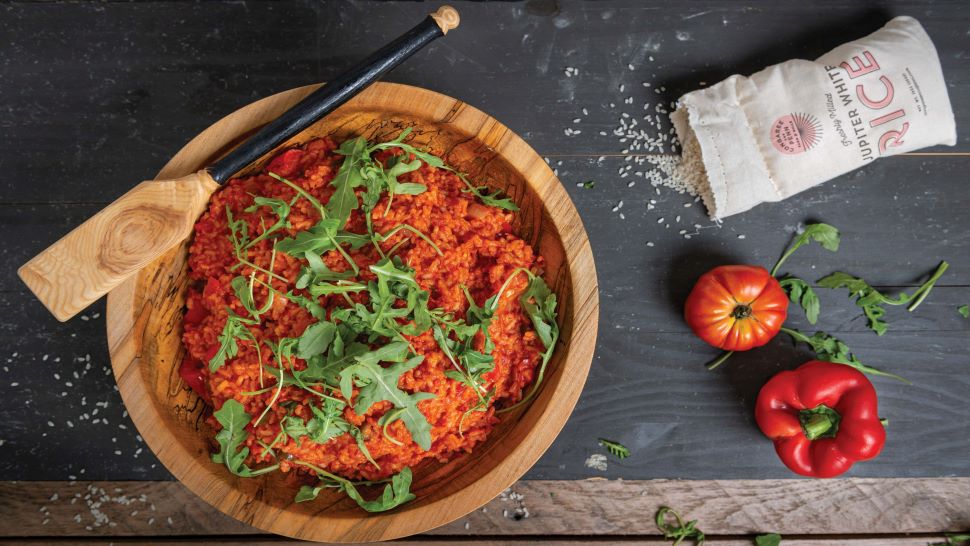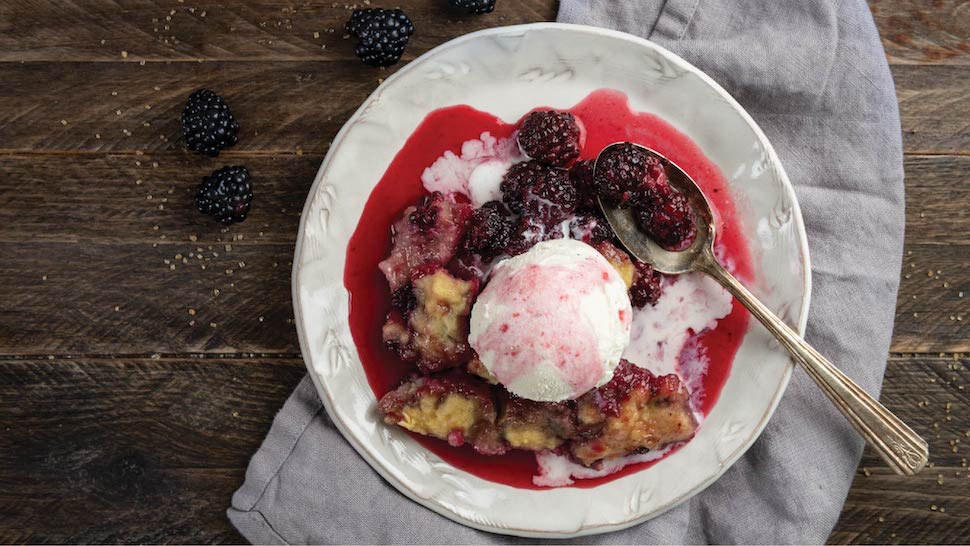Juneteenth Recipes from CheFarmer Matthew Raiford
- by bonappetit

During this year’s observation of Juneteenth, we’re partnering with CheFarmer Matthew Raiford, who last joined Bon Appétit teams across the country in their celebration of Black History Month. Matthew resides on land purchased by his great-great-great grandfather Jupiter Gilliard, who after being emancipated from slavery accumulated 450 acres in Glynn County, Georgia. Matthew has graciously shared recipes from his family table with us, for you. Read on to explore Matthew’s Juneteenth recipes!
CheFarmer’s Gazpacho
When I returned to Glynn County, Georgia, after vowing never to come back, my life somewhat paralleled those of my great uncles, who worked at the Jekyll Island Club during the week and farmed over the weekends. I served as the executive chef for the Lodge on Little St. Simons Island, an all- inclusive eco- resort accessible only by boat. There, I got reacquainted with the land and waterways I had taken for granted as a child, and I began to see them with new eyes and listened to the voices of those elders. This gazpacho recipe came out of my wanting to share the bounty of this land with our guests.
Serves 6 to 8
- 4 cups tomato juice
- 8 Cherokee Purple tomatoes, chopped and seeded
- 2 lemon cucumbers, chopped
- 1 medium red onion, chopped
- 1 medium Vidalia onion, chopped
- 1 red bell pepper, chopped and seeded
- 3 tablespoons kosher salt
- 2 tablespoons cumin
- 1 elephant garlic clove, peeled and roughly chopped
- 1/2 teaspoon cayenne pepper
- 3/4 cup red wine vinegar
- Crème fraîche for serving
DIRECTIONS
- Add the ingredients in stages into the bowl of a food processor— first the tomato juice and tomatoes, then the cucumbers and onions, then the bell pepper, then the salt, cumin, garlic, and cayenne pepper, finishing with the vinegar— and pulse until you achieve the desired consistency (not pure liquid, but thoroughly combined and textured).
- Taste and adjust seasonings accordingly. Serve chilled with a dollop of crème fraîche.

Watermelon Steak Salad with Heirloom Tomatoes and Sangria Vinaigrette
I grew up eating Georgia Rattlesnake watermelons— that’s really what they’re called, because the dark green stripes resemble a diamondback rattlesnake. These heirloom varietals, which can grow up to 40 pounds, have a deep reddish pink flesh that is sweeter than sweet. Folks started growing them around here in the 1830s. When I was a kid, we’d throw them in the back of the truck and take them to market. Because they are harder to come by now, and because people have grown accustomed to seedless watermelons, I created this recipe to accommodate either. But I absolutely prefer a rattlesnake watermelon, which we grow at Gilliard Farms.
Serves 4 to 6
FOR THE SALAD
- 1 to 11/2 pounds freshly mixed salad greens or microgreens
- 1 pound heirloom tomatoes of varying sizes and colors, such as Cherokee Purple, Yellow Brandywine, black and yellow cherry tomatoes
- 1/4 medium seedless watermelon (5 to 10 pounds)
- Olive oil for brushing
FOR THE VINAIGRETTE
- 1 cup traditional red sangria, either homemade or store-bought
- 1/2 cup olive oil
- Freshly cracked black pepper
- Sea salt
DIRECTIONS
- Prepare your grill for medium- high direct heat, 375° to 450°F.
- While the grill comes up to temperature, wash and dry the salad greens, then divide the greens among four to six serving plates. Wash and dry your tomatoes. Slice the whole tomatoes into ½- inch rounds and halve the cherry tomatoes. Divide and arrange the tomato slices evenly among the plates. Set the plates in the refrigerator to chill while you finish the dish.
- Slide the watermelon into ¾- to- 1- inch- thick “steaks,” then quarter the steaks into wedges. Brush each side of the watermelon with a little olive oil, then set the wedges on the grill for approximately 3 minutes per side, until you get grill marks. The longer you leave the wedges on, the sweeter they’ll get. Remove the watermelon from the grill and arrange evenly among the salad plates.
- Pour the sangria into a large measuring cup with a pouring spout, then whisk the olive oil into the sangria until it makes a nice, loose vinaigrette. Generously dress the salads. Sprinkle the salads with pepper and salt to your liking, then serve.
Herb Chicken in Goober (Peanut) Sauce
My mom never much talked with me about being a farmer, even when I returned to the farm. Truth is, she never thought I would stay because I had been so emphatic about leaving and never coming back. But now, she shares things with me as we walk and I show her what I’m doing with rotational crops. She points and says, “This was the watermelon patch. Remember, this is where the chicken coop was.” Not long ago, we were walking near the woods and she said, “Granddaddy used to grow peanuts right here. He’d run the hogs through here the last months to fatten them up.” A mast crop for hogs was just one among George Washington Carver’s list of 300 uses for the peanut, which included peanut butter and hair oil. I’ve got one more to add to his list: this Geechee interpretation of pad Thai. Serve with rice.
Serves 4 to 6
- One 4- to 6-pound whole chicken, cut into 8 pieces
- 2 tablespoons dried sage
- 1 tablespoon dried thyme
- 1 tablespoon dried oregano
- 1 tablespoon pink Himalayan salt
- 2 teaspoons salt- free vegetable- pepper seasoning blend
- 2 tablespoons bacon grease (or vegetable oil)
- 1 medium red onion, finely diced
- 1 bell pepper, finely diced
- 1/2 cup creamy peanut butter
- 2 cups chicken stock
- One 13.5- ounce can coconut milk
- 1 tablespoon fermented hot pepper sauce
- 2 cups cooked basmati rice
- 1/4 cup unsalted roasted peanuts, chopped, for garnish
- 1 bunch fresh culantro (yes, culantro not cilantro), roughly chopped, for garnish
DIRECTIONS
- Wash and pat dry the chicken and place the pieces in a large sealable bag. Combine the sage, thyme, oregano, salt, and pepper seasoning blend in a small bowl, then toss the chicken pieces in the bag with the herbs to coat them all over.
- In a 12- inch cast- iron skillet, melt the bacon grease on medium heat. Add the chicken pieces and sear all over, about 2 minutes on each side. Once seared, push the chicken pieces to the side of the skillet, then add the onions and bell pepper and sauté just until the onions start to turn translucent, approximately 3 to 5 minutes. Add the peanut butter and stir to coat the chicken.
- Add the stock, coconut milk, and pepper sauce and turn the heat up just until the stock starts to boil, then turn the heat down to a low simmer and cover. Let the chicken cook for 20 minutes or until it reaches an internal temperature of 165°F.
- Serve over basmati rice and garnish with chopped peanuts and fresh culantro.
TIP: If culantro is hard to find, substitute with cilantro or flat- leaf parsley.

Saffron and Coconut Milk Rice
This sunny, delicate, and fragrant rice dish can serve as a flavorful side dish. Because of its light floral notes and natural sweetness, this rice dish can serve as a gluten- and dairy- free decadence for people with food allergies. I prefer this rice as a one- pot savory dish, served with roasted vegetables and seasoned with white pepper and pink Himalayan salt. For a sweeter version, stir in 1 cup chopped fresh mango or pineapple.
Serves 4 to 6
- One 13.5- ounce can coconut milk
- 1½ cups warm water
- 10 saffron threads
- 2 teaspoons pink Himalayan salt
- 3 cups white rice
- ½ teaspoon white pepper
DIRECTIONS
- In a medium saucepan over high heat, stir together the coconut milk and water. Add the saffron threads and salt, then bring the liquid to a boil.
- Add the rice and turn the heat down to a simmer, allowing the rice to cook for 20 minutes. Check to ensure all the liquid is absorbed before removing the rice from the heat. Sprinkle with the white pepper and fluff with a fork before serving.
Farmhouse Burger with Tomato Jam
I used to question my mom’s meatloaf, whether I should like that mound of ground beef mixed with breadcrumbs and egg as the binder and then shellacked with ketchup. I knew she made it this way to make ground beef go further at mealtime. Yet that old meatloaf came to mind when I was thinking up a recipe for a juicy, out- of- this- world burger. I wanted to put to use the best things from the farm, like late- season tomatoes in a jam, as well as to incorporate a little heat from down island. Serve with roasted purple potatoes, tossed with salt, pepper, and olive oil.
Serves 8
- 1 tablespoon pink Himalayan salt
- ¹⁄8 teaspoon freshly ground black pepper
- 1 egg
- 2 tablespoons water
- 2 pounds ground beef
- 1 pound ground lamb
- 1 pound ground chorizo sausage
- 1/4 cup golden flax meal
- 2 tablespoons Jerk Seasoning (page 93)
- 4 tablespoons clarified butter or ghee
- 8 pretzel buns
- Tomato Jam (recipe follows)
- 8 fresh duck or chicken eggs
DIRECTIONS
- Mix together the salt and pepper, then in a separate small bowl whisk the egg and water. Set these aside. Combine the ground beef, lamb, chorizo sausage, flax meal, Jerk Seasoning, salt and pepper mixture, and egg in a large bowl. Mix the ingredients with your hands until well combined. Shape the ground meat mixture into 8 burger patties. (I shape my burgers like I did when I was kid. They almost look like a mini round meatloaf, then I slightly flatten them using the palm of my hand.)
- In a large cast- iron skillet over medium heat, melt 2 tablespoons of the butter, then place 4 burger patties in the pan, making sure not to crowd the skillet. Cook the patties 3 to 4 minutes on each side, longer if you desire them well done. Set the patties aside and cover with foil to keep warm, then repeat the process until all the patties are cooked.
- Split the pretzel buns. In the same skillet, melt another tablespoon of butter and toast the pretzel buns until golden brown and slightly crisp. Once toasted, slather Tomato Jam on each side of the bun and layer on the burger patty.
- Melt another tablespoon of butter in the skillet and fry the eggs to your liking in two batches of four. Set one fried egg on each hamburger patty.
Tomato Jam
Makes 4 cups
- 3 pounds beefsteak tomatoes, diced
- 2 teaspoons olive oil
- 4 garlic cloves, minced
- 2 shallots, peeled and roughly chopped
- 1 cup apple cider vinegar
- 2 teaspoons Dijon mustard
- 1 tablespoon vindaloo curry paste
- 1 cup honey
- 1/2 teaspoon crushed red pepper flakes
- Sea salt and cracked black pepper to taste
DIRECTIONS
- In the bowl of a food processor, puree the tomatoes until they are the consistency of a marinara sauce.
- In a heavy- bottomed stockpot, heat the olive oil over medium- high heat and sauté the garlic and shallots until caramelized, approximately 7 to 10 minutes.
- Add the vinegar, mustard, curry paste, honey, and red pepper flakes, stirring until just combined. Incorporate the tomato puree and allow the jam to start to bubble. Turn down the heat by half to a simmer and allow the jam to cook for 30 minutes, stirring frequently until it thickens. Remove the jam from the heat. Taste and adjust the seasoning with sea salt and cracked black pepper. When it is to your liking, let the jam cool to room temperature. Store in an airtight container in the refrigerator for up to 2 weeks.
Note: Because we have an 11- month growing season in the Southeastern United States, we get a rolling harvest of tomatoes beginning in late December in Florida and continuing to early June in North Carolina. Georgia tomatoes hit the height of taste during April and May. This versatile jam gets its kick from curry paste, and it is an ideal condiment for grilled burgers and sausages, and as a rub on chicken, lamb, and pork.

Blackberry Doobie
I call the woods around the farm Where the Wild Things Are, because great-grandmother Florine’s mimosa trees and great-grandfather Horace’s blackberries and muscadines have all volunteered and gone a little crazy back in there, where they are free to flourish. As a kid, we had wild blackberries growing along the edges of the ditch when Galilee Road beside our farm was a dirt road. When they were ready for picking, my cousins and I would fill our buckets with more blackberries than Nana could possibly use because we knew if we did, she would say, “Now, y’all done picked enough for to make a doobie.” A doobie is kind of like a cobbler, but it’s more akin to sweet dumplings. Serve warm with fresh whipped cream, vanilla bean ice cream, or a scoop of gelato. When you take a bite, you’ll taste summer for real.
Serves 8 to 10
- 4 pints blackberries
- 1/2 cup Sucanat or granulated sugar
- 2 tablespoons arrowroot or cornstarch
- 1 cup cold water
- 4 tablespoons cold butter
- 1/2 batch Hot Buttermilk Biscuits dough (page 45)
DIRECTIONS
- In a large pot, toss the blackberries with the sugar and arrowroot. Let the blackberries sit for 20 minutes, then add the water and butter and turn on the heat to medium. Once the blackberries come to a boil, turn the heat down to simmer.
- While the blackberries simmer, use a tablespoon to drop biscuit dough onto the surface of the blackberries until you’ve used up all the dough. Cover the pot and cook for 15 to 20 minutes, until the dough is cooked through.
NOTE: Sucanat is simply a less- processed derivative of natural sugarcane and involves no chemicals in the making the way white granulated sugar does. The gift: a healthier sweetener with a richer, more complex flavor profile, which means you need less of it in a recipe.